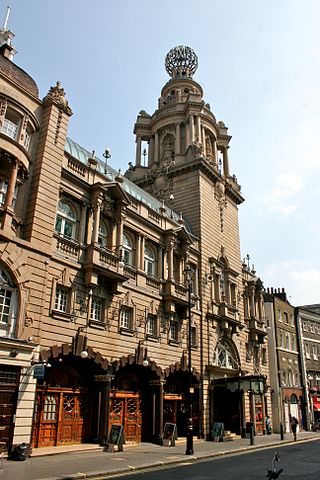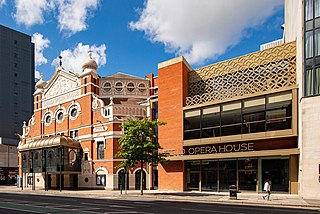
Everyman Theatre is a theatre based in Regent Street, Cheltenham. There are two auditoria in the building - the 718 seat main auditorium and the 60 seat Studio Theatre, originally named The Ralph Richardson Studio after Ralph Richardson.

Everyman Theatre is a theatre based in Regent Street, Cheltenham. There are two auditoria in the building - the 718 seat main auditorium and the 60 seat Studio Theatre, originally named The Ralph Richardson Studio after Ralph Richardson.
The Grade II listed building was designed by Frank Matcham and was originally called "The New Theatre and Opera House". [1] It was opened on 1 October 1891 with a performance by Lilly Langtry in 'Lady Clancarty'. [2] [3] When it was first built, the theatre seated around 1500 people on bench seating.
In 1929, the New Theatre and Opera House gained a licence to screen projected film, [4] becoming a multi-purpose theatre and cinema. The licence stipulated that the building must continue to present live performance as well as cinema.
In World War II, the theatre became a Garrison Theatre, [5] continuing to present theatre throughout the war years to civilians and the US soldiers based at Pittville. Many actors from London left the capital to escape the Blitz, bringing big names to Cheltenham.
The Cheltenham Corporation ran the building after World War II until 1960. In 1959 the building closed and was at risk of being sold. [3] The Cheltenham Theatre Association published an advertisement in September 1959 advertising "Urgent - Wanted £3,000 at once, to re-open Cheltenham Opera House".

In May 1960, the Cheltenham Theatre Association published another advertisement titled "Great News", which announced that the Everyman Theatre would open on Monday 22 May 1960 with a world premiere presentation of N.C. Hunter's "A Piece of Silver", starring Joyce Heron and Esmond Knight. The Cheltenham Theatre Association rebranded itself as the Everyman Theatre Association (ETA). It enjoyed booking advantages and raised money for the Theatre. Its 50th anniversary in 2010 was a great success; sadly, Covid lockdown prevented the 60th. Members enjoyed a variety of social activities, but, even before lockdown, support diminished and the ETA was wound up in late 2021. The benefits transferred to a new Priority Access Membership scheme administered directly by the theatre.
On re-opening in 1960, the Everyman Theatre operated as a Repertory Theatre, with several household names being part of the rep, including William Gaunt, Steven Berkoff, Windsor Davies and Penelope Keith.
The theatre closed in 1983 to coincide with the development of the Regent Arcade, during which the building underwent significant rebuilding and refurbishment. The theatre reopened in 1986 with a production of My Fair Lady, starring Jacqueline Dankworth.
The Everyman Theatre is the oldest surviving working Matcham Auditorium. [6] [7]
In 2023, the pantomime Mother Goose removed an anti-vegan song from the show after complaints from audiences. [8]

In 2011, the theatre closed in early May for a £3.2 million refurbishment. [9] During the refurbishment, the main auditorium was restored and returned to a decorative style resembling Frank Matcham's original style, including bespoke wallpaper and carpets, painting by fine arts and replacement of cherubs around the auditorium. The pink paint on the iconic narrow and high Opera House proscenium arch was removed to reveal the original Scagliola marble. [10] Above the proscenium arch, the spandrels were restored to put original paintings representing the angels of Comedy and Tragedy back in place. The theatre reopened in September 2011 with a performance by Sir Ken Dodd. [11]

The London Coliseum is a theatre in St Martin's Lane, Westminster, built as one of London's largest and most luxurious "family" variety theatres. Opened on 24 December 1904 as the London Coliseum Theatre of Varieties, it was designed by the architect Frank Matcham for the impresario Oswald Stoll. Their ambition was to build the largest and finest music hall, described as the "people's palace of entertainment" of its age.

The Theatre Royal is a historic theatre, a Grade I listed building situated on Grey Street in Newcastle upon Tyne.

Buxton Opera House is in The Square, Buxton, Derbyshire, England. It is a 902-seat opera house that hosts the annual Buxton Festival and the International Gilbert and Sullivan Festival, among others, as well as pantomime at Christmas, musicals and other entertainments year-round. Hosting live performances until 1927, the theatre then was used mostly as a cinema until 1976. In 1979, it was refurbished and reopened as a venue for live performance.

Francis Matcham was an English architect who specialised in the design of theatres and music halls. He worked extensively in London, predominantly under Moss Empires for whom he designed the Hippodrome in 1900, Hackney Empire (1901), Coliseum (1903) and Palladium (1910). His last major commission before retirement was the Victoria Palace (1911) for the variety magnate Alfred Butt. During his 40-year career, Matcham was responsible for the design and construction of over 90 theatres and the redesign and refurbishment of a further 80 throughout the United Kingdom.

The Grand Opera House is a theatre in Belfast, Northern Ireland, designed by the most prolific theatre architect of the period, Frank Matcham. It opened on 23 December 1895. According to the Theatres Trust, the "magnificent auditorium is probably the best surviving example in the United Kingdom of the oriental style applied to theatre architecture". The auditorium was restored to its former glory, and the foyer spaces and bars were reimagined and developed as part of a £12.2 million project in 2020/2021, generously supported by the National Lottery Heritage Fund. [1]

The Tivoli Theatre is a theatre in Aberdeen, Scotland, opened in 1872 as Her Majesty's Theatre and was built by the Aberdeen Theatre and Opera House Company Ltd, under architects James Matthews of Aberdeen and Charles J. Phipps, a London-based architect brought in to consult. The auditorium was rebuilt in 1897 by theatre architect Frank Matcham, but then closed temporarily in 1906, following the opening of the larger His Majesty's Theatre. The smaller theatre was extensively reconstructed in 1909, again by Frank Matcham, and re-opened in July 1910 as the Tivoli. The Tivoli was refurbished again in 1938.

The New Theatre is one of the principal theatres of Cardiff, capital city of Wales. It is located in the city centre on Park Place, close to Cathays Park.

The Regent Theatre is a theatre in Stoke-on-Trent, England. Constructed in 1929 as a cinema, it is one of several theatres in the city centre and one of two operated by the Ambassador Theatre Group on behalf of Stoke-on-Trent City Council. The building was converted for full-time use as a theatre in 1999, and since then has hosted a number of shows and musicals. The theatre is also the northern base for the Glyndebourne Touring Opera.

Blackpool Grand Theatre is a theatre in Blackpool, Lancashire, England. Since 2006, it has also been known as the National Theatre of Variety. It is a Grade II* Listed Building.

York Theatre Royal is a theatre in St Leonard's Place, in York, England, which dates back to 1744. The theatre currently seats 750 people. Whilst the theatre is traditionally a proscenium theatre, it was reconfigured for a season in 2011 to offer productions in-the-round. The theatre puts on many of its own productions, as well as hosting touring companies, one of which is Pilot Theatre, a national touring company which often co-produces its work with the theatre. Additionally the main stage and studio are regularly used by local amateur dramatic and operatic societies. York Theatre Royal was one of the co-producers of the historic York Mystery Plays 2012 which were staged in York Museum Gardens between 2–27 August. The theatre reopened on Friday 22 April 2016 following a £6million redevelopment, with a new roof, an extended and re-modelled front of house area, a refurbished and redecorated main auditorium and with major improvements to access and environmental impact.

The Everyman, also referred to as the Everyman Theatre and historically known as the Everyman Palace, is a 650-seat Victorian theatre on MacCurtain Street in Cork, Ireland. It opened in 1897, and is the oldest purpose-built theatre building in Cork. The theatre is housed in a protected Victorian building with a large stage and auditorium, a proscenium arch, four elaborately decorated boxes, a studio space and a bar.

The King's Theatre is a theatre in Edinburgh, Scotland.

The Wolverhampton Grand Theatre, commonly known as The Grand, is a theatre located on Lichfield Street, Wolverhampton. The theatre was designed in 1894 by Architect Charles J. Phipps. It is a Grade II Listed Building with a seating capacity of 1200.

The Ashcroft Theatre is a theatre located within the Fairfield Halls, Croydon, South London. The theatre was named after Croydon-born Dame Peggy Ashcroft and is a proscenium theatre with a stepped auditorium. The mural on its fire curtain is by the artist Henry Bird. A variety of productions are held throughout the year such as drama, ballet, opera and pantomime. The venue has a seating capacity of 763 and can be converted into a cinema as it has a large screen giving full Cinemascope and standard film format.

The Marina is a theatre and cinema in Lowestoft, Suffolk, originally opened in the Victorian era. The venue has an auditorium seating 800. It plays host to major West End productions, top comedy, orchestral concerts, touring drama and musical productions, opera, ballet, music, dance and celebrity concerts as well as operating a successful cinema operation - boasting the largest screen and cinema auditoria in the town. The Marina annually hosts the largest professional pantomime on the East Anglian Coast.

The Southport Winter Gardens was a Victorian entertainment complex in the town of Southport, Merseyside. The original winter gardens comprised a theatre, opera house, aquarium, a small zoo, conservatory, promenades and halls situated under the grand glass domes.
Aberdeen has been the host of several theatres and concert halls through history. Some of them have been converted or destroyed over the years.
The Theatre Royal, Hanley was a theatre in Stoke-on-Trent, England with a long history.

The Everyman Gerrards Cross is a cinema located in Gerrards Cross, Buckinghamshire. Originally known as The Playhouse, it has continually served Gerrards Cross as a cinema since it first opened in 1925 and is the oldest cinema in Buckinghamshire. It has been owned by several cinema chains and is currently operated by Everyman Cinemas.

The Chiswick Empire was a theatre facing Turnham Green in Chiswick that opened in 1912 and closed and was demolished in 1959. A venue for touring artists, some of the greatest names in drama, variety and music hall performed there including George Formby, Laurel and Hardy, Chico Marx, Peter Sellers and Liberace.